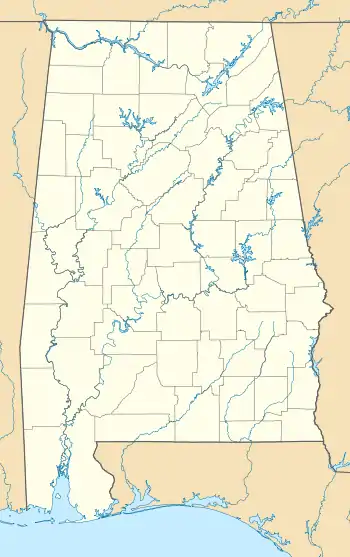Fort Carney
Fort Carney was a stockade fort built in 1813 in present-day Clarke County, Alabama during the Creek War.[1]
| Fort Carney | |
|---|---|
 Location of Fort Carney in Alabama | |
| Location | Clarke County, Alabama |
| Nearest city | Jackson |
| Coordinates | 31°24′18″N 87°54′16″W |
| Built | 1813 |
History
Creek War
After Red Stick warriors began attacking settlers in the area, many families joined together to create protective stockades. Josiah Carney, who moved to Clarke County in 1809 from North Carolina, began building a stockade in 1813 at Carney's Bluff.[2] Carney's Bluff was later known as Gullett's Bluff. Fort Carney was also known as Fort Hawn or Fort Gullett.[3] The fort site was located six miles south of Jackson on the road from Jackson to Mount Vernon.[3]
Sources differ on the number of occupants of Fort Carney. Albert J. Pickett reported 390 individuals occupied Fort Carney, while Timothy Ball stated that it only contained "a few occupants".[4]
Sixty members of the 8th Regiment Mississippi Militia occupied Fort Carney.[5]
Prior to the Fort Mims massacre, it was reported that Red Stick warriors examined Fort Carney but decided to attack Fort Mims instead.[4]
Fort Powell was a stockade fort located three miles south of Fort Carney at Oven Bluff. After the Fort Mims massacre, settlers from Fort Powell moved to Fort Carney before moving to Mount Vernon.[6]
Jeremiah Austill, who gained fame for his participation in the Canoe Fight, stopped at Fort Carney on his ride from Fort Madison to Fort Stoddert. Austill volunteered for the seventy-five mile ride to request additional protection for the occupants of Fort Madison.[7]
American Civil War
During the Civil War, a Confederate fort named Fort Gullett was built on the site of Fort Carney. Fort Gullett was built in 1862 to protect the nearby salt wells.[8] Fort Gullett also served to prevent Federal gunboats from traveling up the Tombigbee River.[9]
References
- Mike Bunn; Clay Williams (1 July 2008). Battle for the Southern Frontier: The Creek War and the War of 1812. Arcadia Publishing Incorporated. p. 40. ISBN 978-1-62584-381-4.
- Harris, W. Stuart (1977). Dead Towns of Alabama. Tuscaloosa, Alabama: University of Alabama Press. p. 38. ISBN 0-8173-1125-4.
- Publications of the Mississippi Historical Society: Centenary series. The Society. 1921. p. 42.
- Timothy Horton Ball (1879). Clarke County, Alabama, and Its Surroundings. Clarke County Historical Society. p. 495.
- Pickett, Albert James (1878). History of Alabama, and Incidentally of Georgia and Mississippi, from the Earliest Period. Tuscaloosa, AL: Willo Publishing Company. p. 546.
- Ball 1879, p. 141.
- Kathryn Tucker Windham (2007). Alabama, One Big Front Porch. NewSouth Books. pp. 48–9. ISBN 978-1-58838-219-1.
- Black Warrior and Tombigbee Rivers Maintenance: Environmental Impact Statement. 1976. p. 41.
- United States. Congress. Congressional Record: Proceedings and Debates of the ... Congress. U.S. Government Printing Office. p. 4185.
